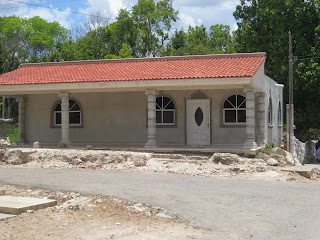and going home to Jonathan. So I'll sign off with a few colors and tidbits:


First, red: flamboyan trees, in brilliant bloom now like New England maples in fall. I've fallen in love with their big exuberant seed pods, called machetes, which get sooo much energy from the monster sun.

I spent three days in Ticul, visiting Carlos Ake' Poot and his family.
His 20 year old daughter takes care of 6 children, her neighbor, 10,
with sibling parents in the States, a boarding-house, everyone off to school in shifts.

This is the family station wagon, a trici.

In Ticul, the taxis are tricis with motorbikes in stead of bicycles.

The littlest kids have to wear topabocas to school for flu protection, but they don't seem to mind.

I'm off on one last trip, to Chetumal for interviews, then it's time for some hard farewells,
but so looking forward to my family and beloved friends...

















